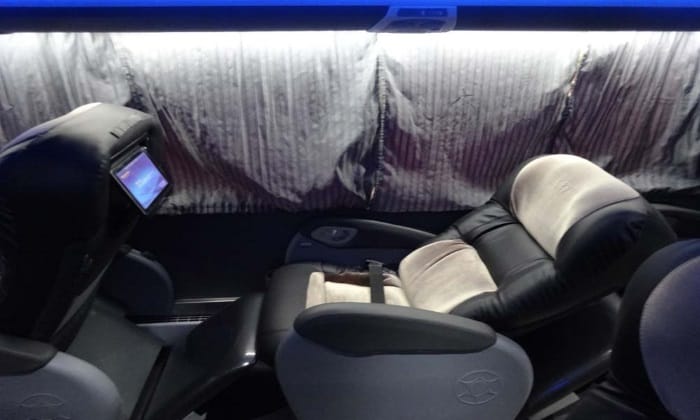How Safe are Night Buses in Peru?
Night buses in Peru are often unavoidable, as many bus companies schedule their departures to run overnight, especially for trips of eight hours or more. And even when there is a choice, many backpackers choose to travel overnight to save money on hostel or hotel costs, and to save time (why waste a day in Peru stuck on a bus when you can travel at night, right?).
Either way, traveling by bus at night raises entirely reasonable safety concerns, particularly regarding accidents and robberies, both of which are more common at night…

VIP-class seat on a Cruz del Sur night bus in Peru (photo © www.cruzdelsur.com.pe)
Advice for Overnight Bus Travel in Peru
According to the British Government’s foreign travel advice website:
“Bus crashes are common [in Peru], especially at night. Only use reputable transport companies, and where possible avoid overnight travel, especially in mountainous and remote regions. Cruz del Sur, Ormeno and Oltursa bus companies operate with two crews, but accidents still occur. Always wear a seat belt.”
The key advice here is to always travel with the best bus companies in Peru, as the smaller companies do not have the same security measures in place and their buses (and their drivers) are not as reliable. Crashes are far less frequent with the major companies, and all too common with the smaller, regional operators.
ENTERTAINMENT TIP: If looking for fun at night, or to watch sports during the day, or even a taste of home, visit the Wild Rover Hostels Chain for great food, sports and beer! Entrance to their bars is free even for non-guests
As for “where possible avoid overnight travel,” sometimes you simply won’t have a choice about traveling during the day or at night. If you check bus schedules at Busportal, you’ll see many 8- to 12-hour trips that run overnight, sometimes with no daytime alternatives (or daytime departures that arrive in the middle of the night, which is not ideal – see below). Then there are the really lengthy journeys, such as Lima to Cusco, whose 18- to 22-hour durations make nighttime travel unavoidable.
When day and night options are both available, then it’s up to you to decide. In almost all situations, I’m happy to take night buses and happy to recommend them to other travelers – as long as it’s a reputable company. On a modern bus with comfortable reclining seats (semi cama or cama), you should be able to get some sleep before arriving safely at your destination in the morning.
Occasionally, however, you should actively avoid taking night buses in Peru. The British Government website specifically warns against bus travel at night in “mountainous and remote regions,” which is a good rule of thumb. Mountain routes are notoriously treacherous due to winding roads, precipitous drops, adverse weather conditions and poor road conditions, while remote regions may carry a greater risk of banditry and potential hold ups.

Most routes along the classic gringo trail are safe at night (even if they do pass through mountainous regions), including Lima to Cusco via Arequipa (not so much so via Abancay, depending on who you ask) and Cusco to Puno, as well as trips along the coastal Pan-American Highway, such as Lima to Trujillo or Nazca.
But if you head further afield and off the well-trodden path, you might be faced with routes that are not nearly so safe at night, and with no big-name bus companies to ride with (just smaller local bus companies). The roads from Tingo Maria to Tarapoto, or Tingo Maria to Pucallpa, for example, are generally fine during the day but not recommendable at night due to potential bandit activity.
If you have any doubts about a particular route, it’s worth doing research online beforehand (or ask some knowledgeable locals for advice) to gauge the safety of night travel along the given route. If you’re still not sure, feel free to contact me and I might be able to help.
Peruvian Bus Schedules and Arriving at Night
Another potential safety concern with night buses is more about the arrival time than the actual journey. Ideally, you want to arrive in a new town or city during daylight hours and not in the middle of the night or too early in the morning.
If, for example, you take an overnight bus from Lima to Trujillo leaving at 9 p.m., you could arrive in Trujillo at 6 a.m. That’s not too bad if you’ve already booked a room and the hostel or hotel knows your arrival time, but not great if you need to find a place to stay when you get off the bus. Even worse is when a bus rolls into town sometime between 2 a.m. and 6 a.m., leaving you tired in unfamiliar territory and literally in the dark – a situation that’s always best avoided.











2 comments for “How Safe are Night Buses in Peru?”